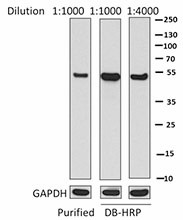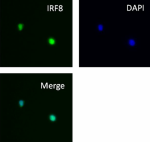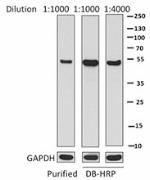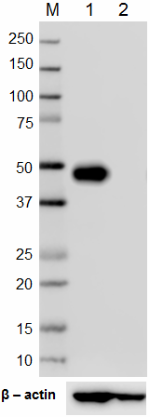- Clone
- 7G11A45 (See other available formats)
- Regulatory Status
- RUO
- Other Names
- Interferon regulatory factor 8, Interferon consensus sequence-binding protein (ICSBP)
- Isotype
- Mouse IgG1, κ
- Ave. Rating
- Submit a Review
- Product Citations
- publications

-

15 µg of total protein extract from THP-1 was resolved by electrophoresis, transferred to a nitrocellulose membrane, and probed with purified or Direct-Blot™ HRP anti-IRF8 antibody (clone 7G11A45). Proteins were visualized using chemiluminescence detection. Purified anti-GAPDH antibody (clone Poly6314) was used as a loading control. -

Total cell lysates (15 µg protein) from THP-1 (lane 1) and HeLa (lane 2) cells were resolved by electrophoresis (4-20% Tris-Glycine gel), transferred to nitrocellulose, and probed with 1:4000 diluted Direct-Blot™ HRP anti-IRF8 Antibody, clone 7G11A45 (upper), or 1:5000 diluted Direct-Blot HRP anti-β-Actin Antibody, clone 2F1-1 (lower). Proteins were visualized by chemiluminescence detection. Lane M: Molecular weight ladder.
IRF8 is a member of the IRF family of transcription factors, playing important roles in IFN signaling pathways and innate immune responses. It regulates hematopoietic cell growth and differentiation of macrophage and dendritic cells. Homozygous IRF8-deficient (IRF8-/-) mice have impaired production of interferon and IL-12, exhibit increased susceptibility to viral pathogens, and have marked expansion of granulocytes that results in a phenotype similar to chronic myelogenous leukemia (CML). IRF8 is also expressed in B lymphocytes, involved in differentiation and commitment of B cell lineage. The DNA-binding activity of IRF8 is significantly increased when interacting with other transcription factors, such as the other members of the IRF family and the ETS family transcription factors. Therefore, the transcriptional activity of IRF8 is dependent on the transcription factors with which it associates.
Product DetailsProduct Details
- Verified Reactivity
- Human
- Antibody Type
- Monoclonal
- Host Species
- Mouse
- Immunogen
- Partial human IRF8 recombinant protein (116-220 a.a.)
- Formulation
- This antibody is provided in 50% glycerol in aqueous buffered solutions with preservatives.
- Preparation
- The antibody was purified by affinity chromatography and conjugated with HRP under optimal conditions.
- Concentration
- Lot-specific (to obtain lot-specific concentration and expiration, please enter the lot number in our Certificate of Analysis online tool.)
- Storage & Handling
- Upon receipt, the antibody solution should be stored undiluted at -20°C, and protected from prolonged exposure to light.
- Application
-
WB - Quality tested
- Recommended Usage
-
Each lot of this antibody is quality control tested by Western blotting. For Western blotting, the suggested dilution is 1:1000-1:4000. The optimal dilution should be determined by titration for each individual assay of interest.
25 µl and 100 µl of Direct-Blot™ HRP antibody can be used for approximately 5 and 20 Western blots, respectively, at the recommended concentration/dilution. - RRID
-
AB_2617029 (BioLegend Cat. No. 656503)
Antigen Details
- Structure
- 426 amino acids, predicted molecular weight of 48 kD, contains a IRF tryptophan pentad repeat responsible for DNA binding and a C-terminal IRF association domain (IAD) responsible for heterodimerization with other transcription factors
- Distribution
-
Nucleus
- Function
- Transcription factor primarily expressed in hematopoietic cells, regulates expression of type I IFN and IFN-inducible genes in response to viral infection
- Interaction
- Interacts with BATF, JunB, TRIM21, and COPS2
- Cell Type
- B cells, Dendritic cells
- Biology Area
- Cell Biology, Immunology, Innate Immunity, Transcription Factors
- Molecular Family
- Nuclear Markers
- Antigen References
-
1. Minten C, et al. 2012. PLoS One. 7:e49851.
2. Xu H, et al. 2012. Nat. Immunol. 13:642.
3. Ouyang X, et al. 2011. Nat. Commun. 2:314.
4. Shin DM, et al. 2011. PLoS One. 6:e27384.
5. Wang H, et al. 2009. Immunol. Res. 43:109.
6. Qi CF, et al. 2009. Immunol. Res. 45:62. - Gene ID
- 3394 View all products for this Gene ID
- UniProt
- View information about IRF8 on UniProt.org
Related FAQs
Other Formats
View All IRF8 Reagents Request Custom Conjugation| Description | Clone | Applications |
|---|---|---|
| Purified anti-IRF8 | 7G11A45 | WB,ICC,IP |
| Direct-Blot™ HRP anti-IRF8 | 7G11A45 | WB |
Compare Data Across All Formats
This data display is provided for general comparisons between formats.
Your actual data may vary due to variations in samples, target cells, instruments and their settings, staining conditions, and other factors.
If you need assistance with selecting the best format contact our expert technical support team.
-
Purified anti-IRF8

Total cell lysates (15 µg protein) from THP-1 (lane 1) and H... 
THP-1 cells were stained with purified anti-IRF8 (7G11A45) a... 
Immunoprecipitation of IRF8 from THP-1 cell extracts. Lane 1... -
Direct-Blot™ HRP anti-IRF8

15 µg of total protein extract from THP-1 was resolved by el... 
Total cell lysates (15 µg protein) from THP-1 (lane 1) and H...







Follow Us